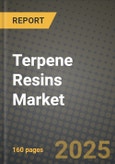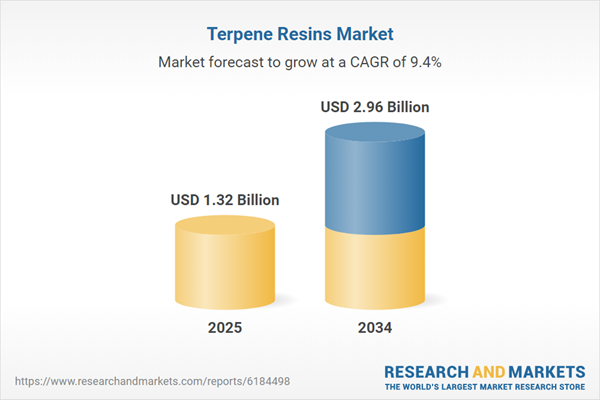Terpene Resins Market
The Terpene Resins Market comprises bio-based tackifiers and modifiers derived primarily from pine chemicals (α/β-pinene, gum turpentine) and citrus streams (d-limonene), including polyterpenes, terpene-phenolic (TPR) resins, hydrogenated grades, and specialty copolymers. Top applications span pressure-sensitive and hot-melt adhesives (labels, packaging, hygiene, construction), rubber compounding and tires, chewing-gum base, inks and overprint varnishes, road-marking and traffic paints, sealants and mastics, and polymer modification for SBC, EVA, and APAO systems. The latest trends emphasize hydrogenation and functionalization for ultra-light color, low odor, and oxidative stability; higher compatibility with SIS/SEBS and metallocene polyolefins; and food-contact or low-VOC profiles for hygiene, packaging, and consumer goods. Growth is propelled by the shift to renewable materials, e-commerce packaging demand, hygiene product penetration, and adhesive line speeds that reward consistent tack and peel performance. The competitive landscape blends integrated pine-chemical producers, specialty resin formulators, and regional compounding houses; differentiation rests on feedstock integration, process control (color, softening point, Mw distribution), and application labs that co-optimize formulas with end users. Suppliers are investing in citrus-based routes to diversify away from pine harvest cycles and in purification/hydrogenation to meet odor and stability specs in premium segments. Constraints include feedstock seasonality and price volatility, competition from C5/C9 hydrocarbon and rosin-ester systems, evolving food-contact and allergen expectations, and the need for reliable global logistics for temperature-sensitive solids. Overall, terpene resins are evolving from niche “natural tackifiers” to performance-validated, low-odor, and highly compatible platforms that enable circularity narratives without sacrificing adhesive productivity or end-use durability.Terpene Resins Market Key Insights
- Hydrogenation unlocks premium use. Fully/partially hydrogenated terpene and terpene-phenolic resins deliver water-clear color, low odor, and oxidative stability - critical for hygiene adhesives, packaging, and electronics assembly.
- Compatibility is king. Tailored polarity and molecular-weight distribution improve solubility with SIS/SEBS, EVA, APAO, and PUR systems, stabilizing viscosity and aging while preserving tack/peel balance.
- Bio-based without compromise. High bio-content from pine or citrus streams enables sustainability claims and LCAs, yet performance parity vs. hydrocarbon tackifiers is maintained through functionalization and precise softening-point control.
- Food-contact pathways. Low-odor, low-NIAS designs and rigorous extractables testing support chewing-gum base and indirect food-contact adhesives, with consistent color and flavor neutrality as buying criteria.
- Rubber & tire adjacencies. Terpene-phenolics enhance green tack and dynamic performance in tread/sidewall compounds; antioxidant synergy and scorch control drive acceptance in high-throughput mixing.
- Ink and coating stability. Light-color polyterpenes improve gloss and fast set in litho/gravure/OPV systems; hydrogenated grades resist yellowing under UV and thermal stress.
- Processability & line speed. Narrow Mw distribution and controlled glass transition reduce stringing and misting in high-speed coaters; predictable rheology lowers downtime and scrap.
- Feedstock resilience. Dual sourcing across gum turpentine, tall-oil turpentine, and citrus d-limonene mitigates seasonality; suppliers invest in purification and isomer control to stabilize specs.
- Regulatory stewardship. Allergen labeling, food-contact compliance, and low-VOC formulations shape portfolios; documentation and change control are decisive in hygiene and packaging tenders.
- Differentiated service. Application labs, hot-melt pilot lines, and co-development programs shorten qualification cycles and de-risk switchovers from hydrocarbon or rosin-ester baselines.
Terpene Resins Market Reginal Analysis
North America
Demand is anchored by packaging, hygiene, and label adhesives, with strong interest in low-odor hydrogenated terpene resins for high-speed converting. Tire and rubber compounds adopt terpene-phenolics for green tack and dynamic balance. Buyers value domestic feedstock integration, consistent color, and technical service for rapid line trials and change control.Europe
Sustainability frameworks and food-contact rigor favor bio-based, low-odor, and low-NIAS terpene systems. PSA and bookbinding markets emphasize light color, aging stability, and recyclability alignment. Regulatory expectations drive hydrogenated and carefully documented portfolios; converters seek EHS stewardship and reliable winter logistics.Asia-Pacific
Scale in hygiene, tapes/labels, footwear, and electronics underpins volume growth. Local pine/citrus streams support cost competitiveness; advanced hydrogenation capacity expands premium segments. Fast qualification cycles reward suppliers with strong application labs; hot/humid conditions elevate oxidation control and storage robustness requirements.Middle East & Africa
Packaging, tissue/hygiene, and building materials drive adoption of stable, light-color tackifiers able to handle heat and dust. Distributors with regional stock and tech support are pivotal. Infrastructure coatings and road-marking segments value terpene-based binders for gloss and dry-through under high irradiance.South & Central America
Adhesives for consumer goods and corrugated packaging lead demand; gum and confectionery maintain niche pull for flavor-neutral, compliant resins. Supply reliability, flexible pack sizes, and local technical assistance guide vendor selection amid currency volatility and variable transport conditions.Terpene Resins Market Segmentation
By Product
- Solid
- Liquid
By Grade
- Technical
- Industrial
By Application
- Inks & coatings
- Adhesives & sealants
- Chewing gums
- Pulp & paper
- Plastic & rubber
- Leather processing
- Others
Key Market players
DRT (dsm-firmenich), Yasuhara Chemical Co., Ltd., Arakawa Chemical Industries, Harima Chemicals Group, Lawter, SI Group, Kraton Corporation, Guangdong KOMO Resin Chemical Co., Ltd., Wuzhou Pine Chemicals Ltd., Guilin Songquan Resin Co., Ltd., Teckrez, Kolon Industries, Eastman Chemical Company, Arkema (Cray Valley), IngevityTerpene Resins Market Analytics
The report employs rigorous tools, including Porter’s Five Forces, value chain mapping, and scenario-based modelling, to assess supply-demand dynamics. Cross-sector influences from parent, derived, and substitute markets are evaluated to identify risks and opportunities. Trade and pricing analytics provide an up-to-date view of international flows, including leading exporters, importers, and regional price trends.Macroeconomic indicators, policy frameworks such as carbon pricing and energy security strategies, and evolving consumer behaviour are considered in forecasting scenarios. Recent deal flows, partnerships, and technology innovations are incorporated to assess their impact on future market performance.
Terpene Resins Market Competitive Intelligence
The competitive landscape is mapped through proprietary frameworks, profiling leading companies with details on business models, product portfolios, financial performance, and strategic initiatives. Key developments such as mergers & acquisitions, technology collaborations, investment inflows, and regional expansions are analyzed for their competitive impact. The report also identifies emerging players and innovative startups contributing to market disruption.Regional insights highlight the most promising investment destinations, regulatory landscapes, and evolving partnerships across energy and industrial corridors.
Countries Covered
- North America - Terpene Resins market data and outlook to 2034
- United States
- Canada
- Mexico
- Europe - Terpene Resins market data and outlook to 2034
- Germany
- United Kingdom
- France
- Italy
- Spain
- BeNeLux
- Russia
- Sweden
- Asia-Pacific - Terpene Resins market data and outlook to 2034
- China
- Japan
- India
- South Korea
- Australia
- Indonesia
- Malaysia
- Vietnam
- Middle East and Africa - Terpene Resins market data and outlook to 2034
- Saudi Arabia
- South Africa
- Iran
- UAE
- Egypt
- South and Central America - Terpene Resins market data and outlook to 2034
- Brazil
- Argentina
- Chile
- Peru
Research Methodology
This study combines primary inputs from industry experts across the Terpene Resins value chain with secondary data from associations, government publications, trade databases, and company disclosures. Proprietary modeling techniques, including data triangulation, statistical correlation, and scenario planning, are applied to deliver reliable market sizing and forecasting.Key Questions Addressed
- What is the current and forecast market size of the Terpene Resins industry at global, regional, and country levels?
- Which types, applications, and technologies present the highest growth potential?
- How are supply chains adapting to geopolitical and economic shocks?
- What role do policy frameworks, trade flows, and sustainability targets play in shaping demand?
- Who are the leading players, and how are their strategies evolving in the face of global uncertainty?
- Which regional “hotspots” and customer segments will outpace the market, and what go-to-market and partnership models best support entry and expansion?
- Where are the most investable opportunities - across technology roadmaps, sustainability-linked innovation, and M&A - and what is the best segment to invest over the next 3-5 years?
Your Key Takeaways from the Terpene Resins Market Report
- Global Terpene Resins market size and growth projections (CAGR), 2024-2034
- Impact of Russia-Ukraine, Israel-Palestine, and Hamas conflicts on Terpene Resins trade, costs, and supply chains
- Terpene Resins market size, share, and outlook across 5 regions and 27 countries, 2023-2034
- Terpene Resins market size, CAGR, and market share of key products, applications, and end-user verticals, 2023-2034
- Short- and long-term Terpene Resins market trends, drivers, restraints, and opportunities
- Porter’s Five Forces analysis, technological developments, and Terpene Resins supply chain analysis
- Terpene Resins trade analysis, Terpene Resins market price analysis, and Terpene Resins supply/demand dynamics
- Profiles of 5 leading companies - overview, key strategies, financials, and products
- Latest Terpene Resins market news and developments
Additional Support
With the purchase of this report, you will receive:- An updated PDF report and an MS Excel data workbook containing all market tables and figures for easy analysis.
- 7-day post-sale analyst support for clarifications and in-scope supplementary data, ensuring the deliverable aligns precisely with your requirements.
- Complimentary report update to incorporate the latest available data and the impact of recent market developments.
This product will be delivered within 1-3 business days.
Table of Contents
Companies Mentioned
- DRT (dsm-firmenich)
- Yasuhara Chemical Co. Ltd.
- Arakawa Chemical Industries
- Harima Chemicals Group
- Lawter
- SI Group
- Kraton Corporation
- Guangdong KOMO Resin Chemical Co. Ltd.
- Wuzhou Pine Chemicals Ltd.
- Guilin Songquan Resin Co. Ltd.
- Teckrez
- Kolon Industries
- Eastman Chemical Company
- Arkema (Cray Valley)
- Ingevity
Table Information
| Report Attribute | Details |
|---|---|
| No. of Pages | 160 |
| Published | November 2025 |
| Forecast Period | 2025 - 2034 |
| Estimated Market Value ( USD | $ 1.32 Billion |
| Forecasted Market Value ( USD | $ 2.96 Billion |
| Compound Annual Growth Rate | 9.4% |
| Regions Covered | Global |
| No. of Companies Mentioned | 15 |









